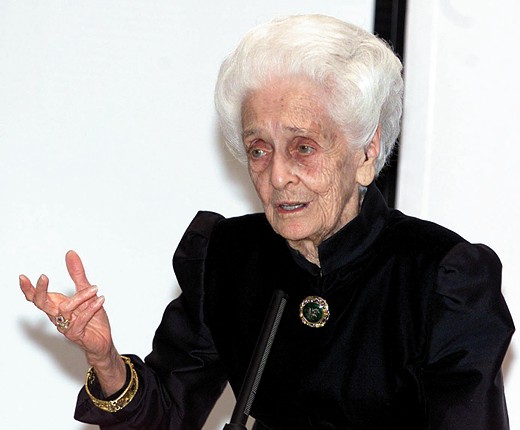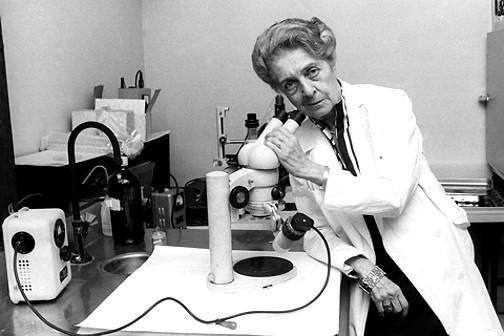Embryology
Rita Levi Montalcini

Rita Levi-Montalcini (Torino 22 April 1909 – Roma 30 December 2012) was an Italian neurologist who, together with colleague Stanley Cohen, received the 1986 Nobel Prize in Physiology or Medicine for their discovery of nerve growth factor (NGF). From 2001 until her death she also served in the Italian Senate as a Senator for Life. Rita Levi-Montalcini had been the oldest living Nobel laureate and the first ever to reach a 100th birthday. On 22 April 2009, she was feted with a 100th birthday party at Rome's city hall.
Born on 22 April 1909 at Turin to a wealthy Italian Jewish family, together with her twin sister Paola she was the youngest of four children. Her parents were Adamo Levi, an electrical engineer and mathematician, and Adele Montalcini, a painter. In her teenage years, she considered becoming a writer and admired Swedish writer Selma Lagerlöf. Adamo discouraged his children from attending college as he feared it would disrupt their lives as wives and mothers but he eventually supported Levi-Montalcini's aspirations to become a doctor anyway. Levi-Montalcini decided to attend University of Turin Medical School after seeing a close family friend die of stomach cancer. While attending, she was taught by neurohistologist Giuseppe Levi who introduced her to the developing nervous system. After graduating in 1936, she went to work as Giuseppe Levi's assistant, but her academic career was cut short by Benito Mussolini's 1938 Manifesto of Race and the subsequent introduction of laws barring Jews from academic and professional careers.
Levi-Montalcini conducted experiments from a home laboratory, studying the growth of nerve fibers in chicken embryos, which laid the groundwork for much of her later research. (She described this experience decades later in the science documentary film Death by Design/The Life and Times of Life and Times (1997), which also features her identical twin sister Paola, who had entered a decades-long career in the arts.) Her first genetics laboratory was in her bedroom at her home. In 1943, her family fled south to Florence, and she set up a laboratory there also. Her family returned to Turin in 1945.
In September 1946,
Levi-Montalcini accepted an invitation to Washington University in St. Louis,
under the supervision of Professor Viktor Hamburger![]() . Although the initial
invitation was for one semester, she stayed for thirty years. It was there
that she did her most important work: isolating the nerve growth factor (NGF)
from observations of certain cancerous tissues that cause extremely rapid
growth of nerve cells in 1952. She was made a Full Professor in 1958, and in
1962, established a research unit in Rome, dividing the rest of her time
between there and St. Louis. From 1961 to 1969 she directed the Research
Center of Neurobiology of the CNR (Rome), and from 1969 to 1978 the Laboratory
of Cellular Biology.
. Although the initial
invitation was for one semester, she stayed for thirty years. It was there
that she did her most important work: isolating the nerve growth factor (NGF)
from observations of certain cancerous tissues that cause extremely rapid
growth of nerve cells in 1952. She was made a Full Professor in 1958, and in
1962, established a research unit in Rome, dividing the rest of her time
between there and St. Louis. From 1961 to 1969 she directed the Research
Center of Neurobiology of the CNR (Rome), and from 1969 to 1978 the Laboratory
of Cellular Biology.
Rita Levi-Montalcini founded the European Brain Research Institute in 2002, and then served as its president. Her role in this institute was at the center of some criticism from some parts of the scientific community in 2010. Controversies were raised about the cooperation of Levi-Montalcini with the Italian pharmaceutical industry Fidia. While working for Fidia, she improved the understanding of gangliosides.
Beginning in 1975, the scientist supported the drug Cronassial (a particular ganglioside) produced by Fidia from bovine brain tissue. Independent studies showed that the drug actually could be successful in treatment of intended diseases (periphrastic nervous system neuropathies). Years later, some patients under treatment with Cronassial reported a severe neurological syndrome (Guillain-Barré syndrome). As per the normal cautionary routine, Germany banned Cronassial in 1983, followed by other countries. Italy prohibited the drug only in 1993; at the same time, an investigation revealed that Fidia paid the Italian Ministry of Health for a quick approval of Cronassial and later paid for pushing use of the drug in treatment of diseases where it had not been tested. During the investigation, one of the witnesses spoke about the use of Levi-Montalcini as a sponsor for the drug, even suggesting that the Nobel prize could have been "sponsored", and serious criticism was levied at Levi-Montalcini.
In the 1990s, she was one of the first scientists pointing out the importance of the mast cell in human pathology. In the same period (1993) she identified the endogenous compound palmitoylethanolamide as an important modulator of this cell. This line of research led to a new inroad in treating chronic pain and neuro-inflammation using this endogenous compound as an analgesic and anti-inflammatory drug.
On 1 August 2001, she was appointed as Senator for Life by the then President of the Italian Republic, Carlo Azeglio Ciampi. On 28–29 April 2006, Levi-Montalcini, aged 97, attended the opening assembly of the newly-elected Senate, at which the President of the Senate was elected. She declared her preference for the centre-left candidate Franco Marini. Due to her support of the government of Romano Prodi, she was often criticized by some right-wing senators, who accused her of "saving" the government when the government's exiguous majority in the Senate was at risk. She was insulted by neo-fascist politicians such as Francesco Storace. On 17 January 2010, she was present in Rome's main synagogue, during the official visit of Pope Benedict XVI.
Rita Levi-Montalcini died in her home in Rome on 30 December 2012 at the age of 103. Upon her death, the Mayor of Rome, Gianni Alemanno, stated it was a great loss "for all of humanity." He praised her as someone who represented "civic conscience, culture and the spirit of research of our time." Italian astrophysicist Margherita Hack told Sky TG24 TV in a tribute to her fellow scientist, "She is really someone to be admired." Italy's premier, Mario Monti, paid tribute to Levi-Montalcini's "charismatic and tenacious" character and for her lifelong endeavor to "defend the battles in which she believed." Vatican spokesman Federico Lombardi praised Levi-Montalcini's civil and moral efforts, saying she was an "inspiring" example for Italy and the world.
Levi-Montalcini had an older brother Gino, who died after a heart attack in 1974. He was one of the most well known Italian architects and a professor at the University of Turin. She had two sisters: Anna, five years older than Rita, and Paola, her twin sister, a popular artist who died on 29 September 2000, aged 91.
